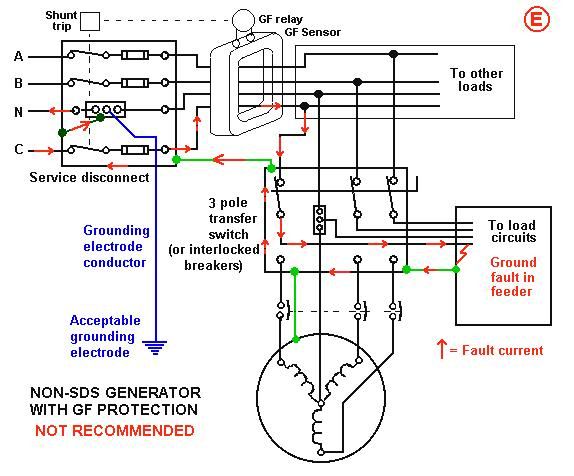muskrat
Member
- Location
- St. Louis, MO
Can't/don't find in art.700-Have seen it both ways. Should the grounded current carrying conductor be switched in a transfer switch for optional stand-by generator?
Can't/don't find in art.700-Have seen it both ways. Should the grounded current carrying conductor be switched in a transfer switch for optional stand-by generator?
Does this mean the grounded conductor? I don't know.700.6 Transfer Equipment.
(A) General. Transfer equipment, including automatic transfer switches, shall be automatic, identified for emergency use, and approved by the authority having jurisdiction. Transfer equipment shall be designed and installed to prevent the inadvertent interconnection of normal and emergency sources of supply in any operation of the transfer equipment. Transfer equipment and electric power production systems installed to permit operation in parallel with the normal source shall meet the requirements of Article 705.
Charlie is that always the case-- a design issue or are the scenarios where you must switch the neutral? Would you mind sharing an advantage to a switched neutral?You haven't seen it because it is not there. It is not a code requirement, but rather is a design choice. It can go either way, and both ways have their advantages and disadvantages. For my part, I will switch the neutral unless someone gives me a good reason not to (i.e., switching is my "defalt" setting). Welcome to the forum.
The path and connections for the equipment grounding conductor are simpler and more nearly sane, when you switch the neutral. If you have the 2008 handbook, take a look at exhibits 250.6 and 250.7. It's not a major thing, but I just don't like the layout of 250.6.Would you mind sharing an advantage to a switched neutral?
If you have a GFP main breaker there are some conditions that can trip the GFP main of you do not switch the neutral at the transfer switch.
OTH a 3 pole transfer switch is less money than a 4 pole transfer switch.
By no means am I an authority on this but I will attempt to answer. I see one thing in art. 700.6(A) that could be construed as requiring the grounded conductor to be switched but I am not sure that is the intent.
Does this mean the grounded conductor? I don't know.
If that required a switched grounded conductor, I would think the ATS companies would stop making and selling 3 pole ATS's.
Well the section I quoted only applies to art. 700- emergency systems so I wasn't sure. It would not apply everywhere unless that wording is used everywhere.
Yes, I didn't think about that.
But after looking at the quote again, I noticed it says the "inadvertent interconnection". I guess having the neutrals tied together would be considered an intentional interconnection.
Yes, I didn't think about that.
But after looking at the quote again, I noticed it says the "inadvertent interconnection". I guess having the neutrals tied together would be considered an intentional interconnection.
You haven't seen it because it is not there. It is not a code requirement, but rather is a design choice. It can go either way, and both ways have their advantages and disadvantages. For my part, I will switch the neutral unless someone gives me a good reason not to (i.e., switching is my "defalt" setting). Welcome to the forum.
That could be the case, I read it and a flag went up. I never worked on an emergency system generator so I only had the code words and was confused. As far as I knew the switched neutral setup is never required or am I wrong on that?

Most of the facilities I have dealt with recently were labs with a backup generator. The function of the generator was to supply egress lights and a minimum of lab equipment, should the utility fail. That would not require a closed transition, so I have only specified open transition.Charlie, Do you specify closed or open neutral transition?
You haven't seen it because it is not there. It is not a code requirement, but rather is a design choice. It can go either way, and both ways have their advantages and disadvantages. For my part, I will switch the neutral unless someone gives me a good reason not to (i.e., switching is my "defalt" setting). Welcome to the forum.

